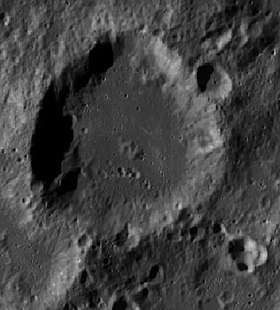Tseraskiy (crater)
Tseraskiy (Ceraski) is an impact crater on the Moon's far side, approximately 66 kilometers (41 mi) in diameter.[1] It is located to the north-northeast of the huge walled plain Planck, and to the southeast of the crater Pauli. To the east-northeast of Tseraskiy is Crocco.
 Imaged by the Lunar Reconnaissance Orbiter | |
| Coordinates | 49.0°S 141.6°E |
|---|---|
| Diameter | 65.59 km |
| Depth | Unknown |
| Colongitude | 219° at sunrise |
| Eponym | Vitol'd K. Tseraskiy |
This is an eroded crater formation and the outer rim has been steady worn down to a roughly circular ridge with rounded edges. This crater overlies an older crater along the southwest side. There is a small crater along the exterior of the rim to the northeast. The interior floor is relatively level and is marked by several small and tiny craterlets, particularly in the western half.
In some publications name has been spelt as Ceraski.
Satellite craters
By convention these features are identified on lunar maps by placing the letter on the side of the crater midpoint that is closest to Tseraskiy.
| Tseraskiy | Latitude | Longitude | Diameter | Ref |
|---|---|---|---|---|
| K | 53.0° S | 144.6° E | 42.7 km | WGPSN |
| P | 51.3° S | 139.6° E | 38.34 km | WGPSN |
See also
- Asteroid 807 Ceraskia
References
- "Tseraskiy (crater)". Gazetteer of Planetary Nomenclature. USGS Astrogeology Research Program.
- Andersson, L. E.; Whitaker, E. A. (1982). NASA Catalogue of Lunar Nomenclature. NASA RP-1097.CS1 maint: ref=harv (link)
- Blue, Jennifer (July 25, 2007). "Gazetteer of Planetary Nomenclature". USGS. Retrieved 2007-08-05.CS1 maint: ref=harv (link)
- Bussey, B.; Spudis, P. (2004). The Clementine Atlas of the Moon. New York: Cambridge University Press. ISBN 978-0-521-81528-4.CS1 maint: ref=harv (link)
- Cocks, Elijah E.; Cocks, Josiah C. (1995). Who's Who on the Moon: A Biographical Dictionary of Lunar Nomenclature. Tudor Publishers. ISBN 978-0-936389-27-1.CS1 maint: ref=harv (link)
- McDowell, Jonathan (July 15, 2007). "Lunar Nomenclature". Jonathan's Space Report. Retrieved 2007-10-24.CS1 maint: ref=harv (link)
- Menzel, D. H.; Minnaert, M.; Levin, B.; Dollfus, A.; Bell, B. (1971). "Report on Lunar Nomenclature by the Working Group of Commission 17 of the IAU". Space Science Reviews. 12 (2): 136–186. Bibcode:1971SSRv...12..136M. doi:10.1007/BF00171763.CS1 maint: ref=harv (link)
- Moore, Patrick (2001). On the Moon. Sterling Publishing Co. ISBN 978-0-304-35469-6.CS1 maint: ref=harv (link)
- Price, Fred W. (1988). The Moon Observer's Handbook. Cambridge University Press. ISBN 978-0-521-33500-3.CS1 maint: ref=harv (link)
- Rükl, Antonín (1990). Atlas of the Moon. Kalmbach Books. ISBN 978-0-913135-17-4.CS1 maint: ref=harv (link)
- Webb, Rev. T. W. (1962). Celestial Objects for Common Telescopes (6th revised ed.). Dover. ISBN 978-0-486-20917-3.CS1 maint: ref=harv (link)
- Whitaker, Ewen A. (1999). Mapping and Naming the Moon. Cambridge University Press. ISBN 978-0-521-62248-6.CS1 maint: ref=harv (link)
- Wlasuk, Peter T. (2000). Observing the Moon. Springer. ISBN 978-1-85233-193-1.CS1 maint: ref=harv (link)